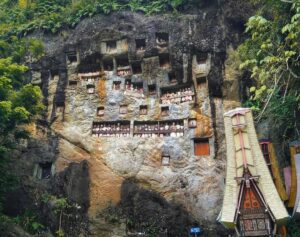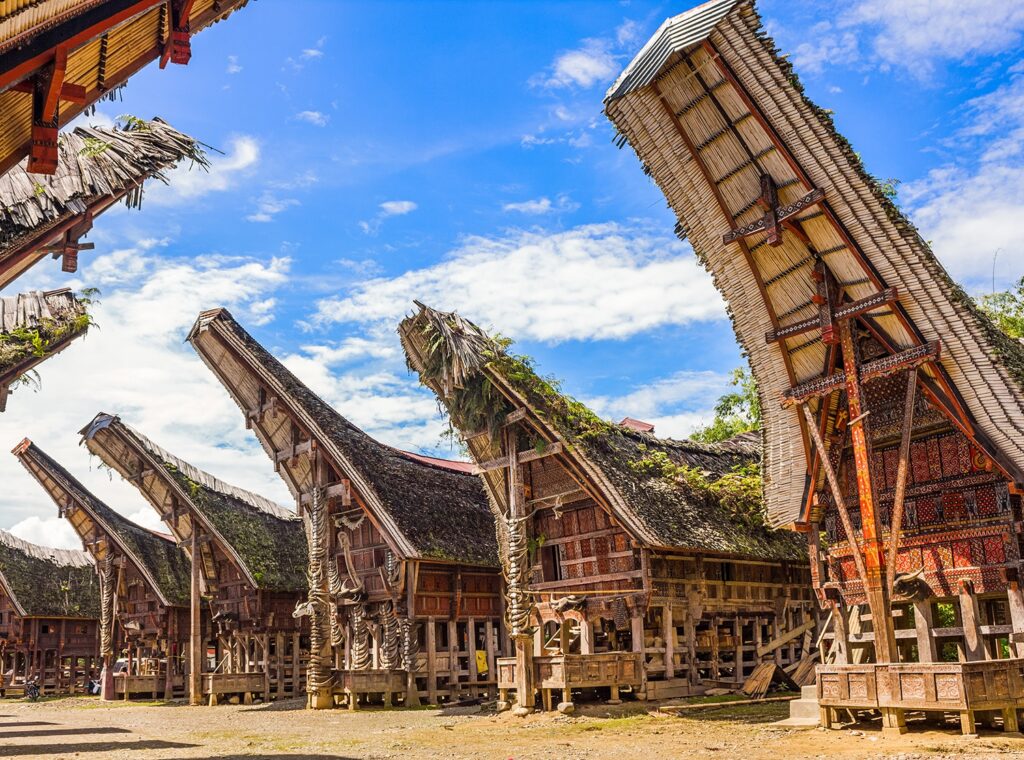Batu Lemo, often referred to simply as Lemo, is one of the most iconic burial sites in Toraja, South Sulawesi. Located in Lemo Village, Mengkendek District, Tana Toraja, this site captures the interest of both local and international tourists with its uniqueness. Besides offering stunning natural views, Batu Lemo showcases a distinct Torajan burial tradition: graves carved directly into towering limestone cliffs.
History and Unique Traditions of Batu Lemo
The graves at Batu Lemo are no ordinary burial sites; they are carved directly into rock cliffs, a tradition that has existed for centuries as part of the Torajan ritual to honor ancestors. According to Torajan beliefs, the higher the burial site, the higher the social status of the deceased. Thus, Batu Lemo also symbolizes the social hierarchy of Torajan society in the past.
Each grave at Batu Lemo is accompanied by wooden effigies known as tau-tau, which are crafted to resemble the appearance of the deceased. These tau-tau figures serve as the embodiment of the deceased’s spirit, standing as guardians of the grave. Positioned on small balconies in front of each grave, these tau-tau figures gaze solemnly at visitors, exuding a sense of reverence.
The Ma’nene Ritual and Other Traditional Torajan Ceremonies
Among the various Torajan cultural ceremonies, one of the most renowned is the Ma’nene ritual, a tradition of cleaning and changing the clothing of the deceased. This ritual is often performed for ancestors laid to rest at Batu Lemo or other Torajan burial sites. Ma’nene demonstrates respect and love for ancestors, while also strengthening family bonds.
In addition to Ma’nene, the Rambu Solo’ funeral ceremony is a grand ritual dedicated to honoring the deceased. Rambu Solo’ ceremonies can last for days and involve a series of traditional processions, dances, buffalo sacrifices, and other offerings. This ritual not only serves as a tribute to the deceased but also as an opportunity for family members, even those who live far away, to gather and reconnect.

The Natural Beauty and Cultural Richness Surrounding Batu Lemo
Batu Lemo is surrounded by lush green landscapes and beautiful hills, making it an enchanting destination for nature and culture enthusiasts. Visitors can enjoy the cool mountain air while observing the unique graves carved into the cliffs. The scenic surroundings offer photographers a rare opportunity to capture the harmony of Torajan culture and nature.
Apart from Batu Lemo, visitors can explore other cultural attractions in Toraja, such as Kete Kesu (a traditional village with Tongkonan houses), Londa (a natural cave burial site), and Buntu Burake, which boasts the largest statue of Jesus in Asia.
Visiting Tips for Batu Lemo
- Best Time to Visit: The dry season (May to September) is ideal for visiting Batu Lemo as the weather is generally more pleasant for travel.
- Respect Local Customs: Batu Lemo is sacred to the Torajan community, so it’s important to honor local customs, such as refraining from disturbing or touching the tau-tau effigies.
- Local Guides: Hiring a local guide is recommended to gain deeper insights into Torajan history and traditions.
- Photography: Visitors are usually allowed to take photos, but they should respect any restricted areas.
Batu Lemo is a site that combines breathtaking natural beauty with deep cultural significance. It not only captivates with its unique aesthetics but also offers a profound lesson in the Torajan approach to life and death. With the presence of tau-tau effigies and cliffside graves, Batu Lemo serves as a silent witness to Toraja’s rich cultural heritage that endures to this day.
Visiting Batu Lemo provides an unforgettable experience, immersing visitors in the wisdom and customs of South Sulawesi.


